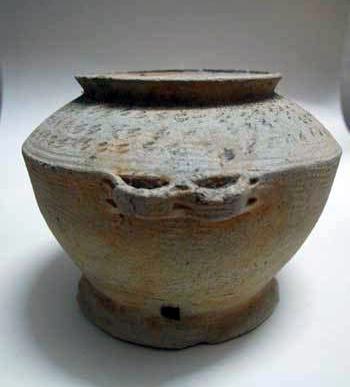Remains of Neolithic through Han Times Found in Tonggu County, Jiangxi
An archaeological team from Jiangxi Provincial Institute of Archaeology and Cultural Relic and Tonggu County Cultural Relics Administration Center conducted a salvation excavation at the Pingdingnao site in Tonggu County in 2010 from July through September. Tens of ancient remains datable to the Neolithic, Shang, Zhou, and Han dynasty were excavated, yielding a group of valuable pottery and stone objects together with some bronzes and jade objects. The most significant discoveries during the excavation include the workshop kiln sites for pottery making, workshop sites for grinding and polishing stone tools, and workshop sites for manufacturing small bronze utensils. The excavation, tracing the beginning of human history in Tonggu County to 4500 years ago, has significantly amplified the historical cultural morphology in northwest Jiangxi. Moreover, it also provides some important data for further studies concerning the ancient settlements and handicraft industry in the region in Pre-Qin times.
Pingdingnao Site is located at the Pingdingnao Hill south of Jinxing Village, Wenquan Town, Tonggu County. An area of 3000 square meters has been excavated.

Remains datable to the Neolithic period are mainly situated along the hill slope in the west of the site. A wealth of stone and pottery objects have been found from the densely distributed waste pits. The stone tools include finely polished but small arrows, axes, and chisels that are either finished or semi-manufactured products. The potteries include potteries with sand inclusion and polished black potteries. Ninety percent of the potteries have sand-inclusion. While they are mainly orange colored, a few are gray in color. Their major types are ding tripods, dou containers, kettles, gui steamers, and spinning wheels. The typical ding tripods are either flat-bottomed and basin in shape or pot-shaped with cone-shaped feet. While the feet of the tripods are usually decorated. Multiple lines are commonly incised on the exterior of the feet, the gui steamers have massive baggy feet. The polished black potteries are typically dou containers with irregular circular openwork. All these indicate that the Neolithic remains in the site belong to the Shanbei Culture which once populated the Xiushui River Valley.
Remains from the Shang culture include mainly stone and pottery objects. The most common among them are trapezoid-shaped ben chisels and U-shaped stone knives with perforations. Jars with open mouth and flanged shoulder, typical of the Wucheng Culture of the Shang dynasty, are finely modeled and fired under high-temperature. At times, their surface is treated with yellow-brownish glaze.
Zhou cultural remains are extensively distributed in the site. They can be divided into two phases.
The early remains are located at the relatively flat, east summit. Six workshops have been found within an area of 200 square meters, indicating that this area originally functioned as a workshop district. The workshops are subterranean houses with passageways, irregular round in shape, 20 to 60 centimeters wide, and 5 to 10 square meters in size. Circular pillar holes of different sizes surround the pits. Some holes tilt toward inside, indicating that each house was originally covered with a simple round steepletop. House F2, in the center of which is placed with a boulder, is rectangular in shape and floored with a layer of fine yellowish clay. It may have been a place for storing and refining the clay for pottery making. The round house F3 measures 5.2 square meters. The surface of the boulder in the middle of the house shows clear traces of grinding, indicating a long period of grinding and polishing activity. Around the boulder are plenty of finished and semi-finished stone products. Also from the same house have been excavated seven pottery molds, indicating this was a workshop for making and polishing the stone tools as well as for manufacturing bronzes. The close relation among the houses may suggest that they be a workshop district with each house allocated with a specified labor. Traces of two overlapping round kilns are found on the slope 10 meters west of this workshop district. One of them measures 10 square meters. Only the gray-yellowish burnt floor has survived. In the west of the kiln district have been found plenty of pits for the purpose of containing the varied wastes related to pottery making. The contents inside these pits are mainly burnt soil, pottery fragments, and solid filling soil. The potteries are mainly of sand-inclusion type, including ding tripods, dou containers, kettles, and jars, among others. The basic shapes of some objects can still be identified.
Remains of the later period show some identifiable distribution as well. No human bones and only small amount of burial objects have been discovered from the two east-west oriented rectangular tombs. A few house remains have also been discovered.
The pit tomb represents the main discovery of Han times. The tomb yields more than 20 burial objects, including pottery, ceramic, and iron objects.
Pingdingnao Site, chronologically spanning from the Neolithic to Han, has yielded a wealth of cultural relics and remains of varied types. It represents an important site in northwest Jiangxi of the Pre-Qin period. Particularly, discoveries in the workshop district for pottery, bronze, and stone manufacture reveal a relatively complicated social structure in administrating the handicraft industry, thus indicating a high level of civilization in the region at the time. (Translator: Wang Yudong)

